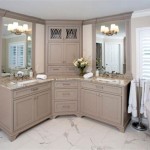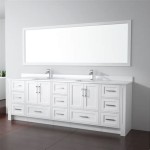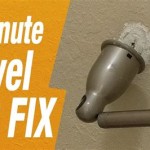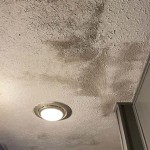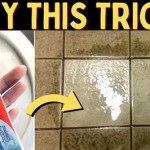```html
Adding Bathroom Accessories Without Drilling: A Comprehensive Guide
Home improvement projects often require balancing aesthetics with practicality, and the bathroom is no exception. While the desire to personalize and organize a bathroom with accessories is common, the prospect of drilling holes in walls and potentially damaging tiles can be a deterrent. Fortunately, a range of innovative and reliable methods exist for installing bathroom accessories without resorting to drilling. This article explores these methods, detailing their applications, benefits, and limitations, providing a comprehensive guide for homeowners seeking a drill-free bathroom upgrade.
Understanding the Alternatives to Drilling
Traditional methods of attaching bathroom accessories involve drilling holes and using screws or anchors. This approach, while secure, carries risks such as cracking tiles, damaging pipes or electrical wiring concealed within walls, and leaving unsightly holes if the accessories are later removed or repositioned. Alternative methods circumvent these issues by relying on adhesive technologies, suction, or tension to securely hold accessories in place. These methods are particularly suitable for renters, those wary of damaging delicate surfaces, or individuals who prefer a more flexible and easily reversible installation process.
The selection of an appropriate alternative to drilling depends on several factors, including the weight and size of the accessory, the type of surface to which it will be attached, and the desired level of permanence. Some methods are better suited for lightweight items like soap dishes or toothbrush holders, while others can support heavier accessories such as towel bars or shower caddies. Furthermore, the surface material plays a crucial role; smooth, non-porous surfaces like tile or glass are ideal for suction-based methods, whereas textured or uneven surfaces may require adhesive solutions.
Adhesive Mounting Solutions: A Detailed Examination
Adhesive mounting is perhaps the most versatile and widely used alternative to drilling for bathroom accessories. This method involves using various types of adhesives, ranging from double-sided adhesive tapes to specialized construction adhesives, to bond accessories to the wall. The key to successful adhesive mounting lies in selecting the appropriate adhesive for the specific application and ensuring proper surface preparation.
Double-sided adhesive tapes are readily available and easy to use, making them a popular choice for lightweight accessories. These tapes typically consist of an adhesive layer on both sides of a carrier material, such as foam or acrylic. Some double-sided tapes are specifically designed for bathroom use, featuring moisture resistance and strong bonding properties. However, it is crucial to select a tape with sufficient weight capacity and to thoroughly clean and dry the surface before application. Rough or porous surfaces may require priming or the use of a thicker tape for optimal adhesion.
Construction adhesives offer a more permanent and robust solution for mounting heavier accessories. These adhesives are formulated to provide a strong, durable bond between various materials, including tile, drywall, and wood. Application typically involves applying the adhesive to the back of the accessory and pressing it firmly against the wall. Some construction adhesives require a clamping period to ensure proper bonding. When using construction adhesives, it is essential to follow the manufacturer's instructions carefully, paying particular attention to drying times and weight limits. It is also advisable to choose an adhesive that is specifically designed for bathroom environments, offering resistance to moisture and mold growth.
Another type of adhesive gaining popularity is suction cup adhesives which combines the power of suction cups with the long-lasting strength of adhesives. These are often used for heavier items and on surfaces where traditional suction cups might struggle to maintain a grip.
Before applying any adhesive, thorough surface preparation is paramount. The surface must be clean, dry, and free of dust, grease, and loose particles. Use a mild detergent and water to clean the surface, followed by a thorough rinsing and drying. For particularly stubborn residues, an isopropyl alcohol wipe can be used. Allow the surface to dry completely before applying the adhesive, as moisture can interfere with the bonding process. On certain surfaces, scuffing the area slightly with fine-grit sandpaper can improve adhesion.
Suction Cup Technology: Leveraging Atmospheric Pressure
Suction cups offer a convenient and easily removable alternative to drilling, relying on atmospheric pressure to create a temporary bond between the accessory and the wall. This method is particularly well-suited for smooth, non-porous surfaces such as tile, glass, and mirrors. However, the effectiveness of suction cups is highly dependent on the quality of the cup, the cleanliness of the surface, and the weight of the accessory.
High-quality suction cups are typically made of durable rubber or silicone and feature a locking mechanism to enhance their grip. These mechanisms often involve a lever or twist lock that creates a tighter seal between the cup and the surface, increasing the suction force. When selecting suction cup accessories, it is important to consider the weight capacity and the intended use. Avoid overloading the suction cups, as this can lead to premature failure and potential damage.
Surface preparation is even more critical for suction cup applications than for adhesive mounting. The surface must be perfectly clean and free of any dirt, dust, or residue. Wipe the surface with a damp cloth and dry it thoroughly before attaching the suction cup. In addition, lightly moistening the rim of the suction cup can help create a better seal. Avoid using cleaning products that contain oils or waxes, as these can interfere with the suction process.
Regular maintenance is essential to ensure the continued effectiveness of suction cup accessories. Periodically check the suction cups for any signs of damage or wear, such as cracks or tears. If a suction cup loses its grip, remove it, clean both the cup and the surface, and reattach it. For enhanced security, consider using a small amount of silicone sealant around the edge of the suction cup, but be aware that this will make the accessory more difficult to remove.
The application of suction cups can be affected by temperature and humidity. In colder temperatures, the rubber or silicone of the suction cup may become less pliable, reducing its gripping power. Conversely, in humid conditions, moisture can accumulate between the suction cup and the surface, potentially weakening the bond. To mitigate these effects, ensure that the bathroom is well-ventilated and avoid placing suction cup accessories in areas that are exposed to direct sunlight or excessive moisture.
Tension Rods and Over-the-Door Hangers: Utilizing Existing Structures
Tension rods and over-the-door hangers offer a different approach to adding bathroom accessories without drilling, utilizing existing structures to support the accessories. Tension rods are typically used in shower stalls or between walls to create a hanging space for towels, shower curtains, or caddies. Over-the-door hangers, as the name suggests, hang over the bathroom door, providing a convenient storage solution for towels, robes, or other items.
Tension rods rely on friction to hold themselves in place between two surfaces. The rod is typically extended until it is slightly longer than the distance between the surfaces, creating tension that prevents it from falling. When selecting a tension rod, it is important to choose one that is sturdy and well-made, with a strong spring mechanism. The weight capacity of the tension rod should also be considered, ensuring that it can support the intended load. Regular adjusting might be needed to ensure perfect tension.
Installation of a tension rod is relatively straightforward. Simply extend the rod to the desired length, compress the spring mechanism, and position the rod between the two surfaces. Release the spring mechanism to create tension and ensure that the rod is securely in place. Periodically check the tension rod to ensure that it remains tight and adjust it as needed.
Over-the-door hangers are another simple and effective way to add storage space to the bathroom without drilling. These hangers typically consist of a metal or plastic frame that hooks over the top of the door and provides hooks or shelves for storing items. When selecting an over-the-door hanger, it is important to choose one that fits securely on the door and does not interfere with its operation. The weight capacity of the hanger should also be considered, ensuring that it can support the intended load. Adding padding to the inside of the hooks can protect the door from scratches. Also, verify the thickness of the hanger, and the space between the door and the frame to ensure a smooth opening and closing.
Both tension rods and over-the-door hangers offer a flexible and easily removable solution for adding bathroom accessories without drilling. However, it is important to be mindful of their weight capacity and to avoid overloading them. Regular maintenance and adjustments may be necessary to ensure that they remain securely in place. They are also limited by the existence of shower walls or doors to hang over, making them less flexible than adhesive solutions.
```
Fixing Bathroom Accessories Without Drilling In Tiles Design Curacao

How To Install A Towel Ring Without Drilling Sugru

Add Bathroom Accessories Without Drilling Diy Toilet Sugru

Bathroom Shelves Without Drilling Rustproof Aluminum Shower Wall Shelf Shampoo Towel Holder Organizer Accessories Set Fruugo Ae

No Drilling Required Towel Bars Installation How To Install

Bathroom Shelves Without Drilling Rustproof Aluminum Shower Wall Shelf Shampoo Towel Holder Organizer Accessories Set Fruugo

Triangle Rack Bathroom Storage Shelves No Drill Wall Mount Corner Shelf Shower Holder For Toilet Shampoo Organizer Accessories Temu United Kingdom

Shower Caddy Self Adhesive Glue Bathroom Shelf No Drilling Wall Mounted Rustproof Aluminum Accessories Silver Rectangle Fruugo Ae

Soap Rack No Drilling Wall Mounted Double Layer Holder Sponge Dish Bathroom Accessories Dishes Self Adhesive Shein

How To Add Bathroom Accessories Without Drilling
Related Posts

